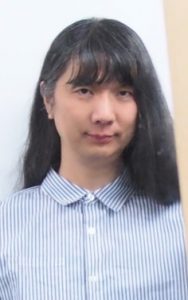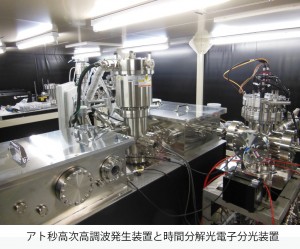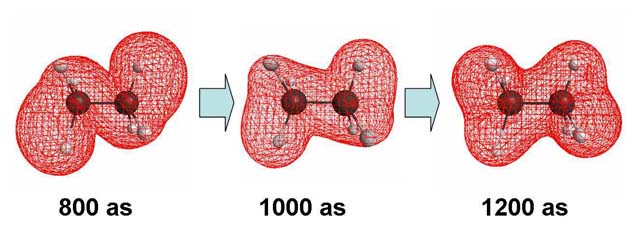
ページ読込中...

ページ読込中...

[English]
| 新倉 弘倫 [教授] |  |
|
| homepage | https://niikura.w.waseda.jp | |
| 専門分野 | 超高速レーザー分光、アト秒物理 | |
| 研究テーマ・研究活動 | ||
| 2000年 総合研究大学院大学 数物科学研究科 博士後期課程修了 博士(理学) 2000年 カナダ国立研究機構(National Research Council) 研究員 2004年-2012年 科学技術振興機構 さきがけ研究員 2010年 早稲田大学先進理工学部 准教授 2012年 文部科学大臣表彰 科学技術賞(研究部門) 2013年 日本学術振興会賞 2015年 現職 |
||
本研究室では、赤外から極端紫外領域の超高速レーザー分光・測定技術の開発と、それを用いた原子や分子の量子ダイナミックスの測定を行っています。測定の時間領域は数フェムト秒(fs, 10-15秒)からアト秒(as, 10-18秒)という極限的な領域で、この時間領域では物質(分子)の構造変化よりも早く運動する電子の刻一刻の姿を測定することが可能です。そのため本研究室では、キャリアエンベロープ位相が安定化した高強度のレーザー系(~6mJ/pulse, 1KHz, 35fs)を用いて高強度5フェムトパルスおよびパルス幅が数百アト秒以下のアト秒パルスを発生し、光電子分光法や吸収分光法と組み合わせることで、原子や分子内の電子運動やそのイオン化過程がどのように起こっているのかを時間分解で測定することや、分子の波動関数をイメージング測定する方法などを開発しています。
従来のフェムト秒科学では、分子や固体などの構造(核間距離や角度)の変化を実時間で追跡することが行われていました。しかし、反応の選択性や反応効率、また様々な物性などの発現には、電子波動関数(分子軌道)の広がりやその位相が重要な役割を果たしています。アト秒科学の方法(再衝突電子法や高次高調波分光)などを用いることで、分子構造が変化するよりも速い時間で、分子内の電子波動関数がどのように変化するのかを測定することが可能になります。特に、原子・分子内における多電子の相関過程は興味の対象になります。
 また極端紫外領~軟X線領域では、従来、コヒーレントかつパルス幅の短いレーザー光源を用いることは困難でした。これらのエネルギー領域は原子・分子の量子ダイナミックスだけではなく、マテリアルサイエンスやバイオイメージングなどにも重要な領域です。アト秒高次高調波などの様々な超高速分光法により、より速い時間領域かつ良い空間分解能で、電子波動関数(分子軌道)の変化を元にした新たな物理現象および物理化学的過程の発見を期待しています。
また極端紫外領~軟X線領域では、従来、コヒーレントかつパルス幅の短いレーザー光源を用いることは困難でした。これらのエネルギー領域は原子・分子の量子ダイナミックスだけではなく、マテリアルサイエンスやバイオイメージングなどにも重要な領域です。アト秒高次高調波などの様々な超高速分光法により、より速い時間領域かつ良い空間分解能で、電子波動関数(分子軌道)の変化を元にした新たな物理現象および物理化学的過程の発見を期待しています。| Hiromichi Niikura [Professor] |  |
|
| homepage | https://niikura.w.waseda.jp | |
| research field | Attoseconds and Ultra-fast Spectroscopy | |
| research keywords | ||
| Intense Laser Attosecond Physics Quantum |
||
| link | ||
| Research Profiles (at Faculty of Science and Engineering)Research Profiles (Elsevier SciVal Experts) | ||
The best time-resolution of measurements has now reached less than a few-hundred attoseconds (1attosecond = 10-18 s). In this time scale, “pure” electron motion can be explored because most molecular structural changes can eventually be frozen. Our aim is to make advancements in the methodology for ultra-fast measurements and coherent imaging technology for wavefunctions. Attosecond science develops precision measurement technologies, and has a possibility to renew quantum physics because of its excellent time-resolution and unique features for measurements. We focus on the following research subjects:
(1) Attosecond measurement
There are two approaches for attosecond science. One is to use optical pulses with photon energy in the extreme ultraviolet region, which is referred to as “high-harmonic generation.” The other is to use the electron pulses, which is referred to as the “attosecond re-colliding electron.” In both approaches one can measure nuclear and electron dynamics in attosecond time-resolution. For instance, we have measured the molecular vibrational motion of Deuterium and the electron wavepacket motion in ethane on ever-faster time scales. We further try to generate shorter pulses and to develop experimental attosecond approaches for measuring electron dynamics during complex molecular reactions.
(2) Imaging wavefunctions
What is a wavefunction Can we observe it directly A wavefunction itself is given by a complex function. According to the statement of Max Born, the square of the amplitude of the wavefunction in unit volume represents the probability to find a particle in the unit volume. On the other hand, taking the square of the amplitude of the wavefunction eliminates the information on the phase. The phase of the wavefunction is critical to understanding chemical reaction dynamics, as has been shown in Frontier Orbital theory. However, so far it has been thought that the wavefunction itself, including the phase information, cannot be observable. On 2004, we showed that attosecond “re-collision” technology made it possible to observe the wavefunction itself. Our approach, referred to as “molecular orbital tomography,” is based on the fact that tunnel ionization and electron re-collision act as a quantum optical interferometer. We will extend this approach in order to apply many molecules and measure dynamical change.
(3) Quantum control of molecules
When we shine intense, short laser pulses on a molecule, a large Stark shift is induced in the energy levels of the molecule. The amount of the Stark shift depends on both the internal and external coordinates of the molecule. Thus, applying short laser pulses to coherently created molecular wavepackets, we can align or orientate molecules, or control the atoms in a molecule. This technique is referred to as “molecular optics.” Using attosecond laser technology, we try to control electron motion in molecules according to our desires in ever faster time scales.

Attosecond electron wavepacket motion in ethane (C2H6). 1as = 1 attosecond = 10-18 second.